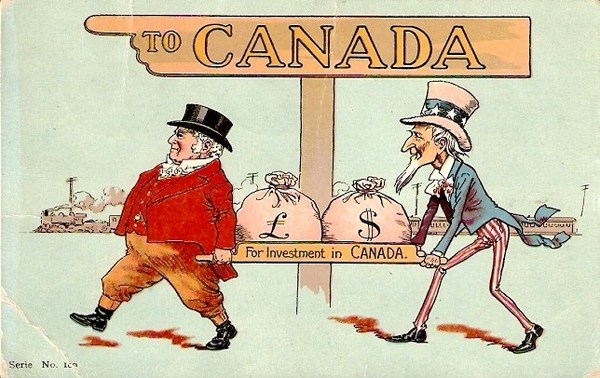The Prime Minister: Architect of Modern Canada

Source: Courtesy of Wikimedia Commons
Laurier and the Economy
In 1896 Wilfrid LAURIER and the Liberals came to power in a climate that seemed to favour investment, the development of infrastructure [see Transportation Infrastructure], and the increase of industrial output, as the following excerpt from the biography of Clifford SIFTON, minister of the interior, indicates:
“The Laurier government took office in propitious times. The domestic economy was recovering, the international economy was expanding, there was new demand in Europe for North American foodstuffs and manufactures, the last waves of emigrants from central and eastern Europe were ready to go abroad, and capitalists from Britain and the United States were prepared to invest unprecedented amounts of money in Canada.”
Laurier thus instituted a series of policies that would, as his biographer indicates, earn him the title of architect of modern Canada. From 1897 on, for example, he sought to restore relative harmony among major Canadian economic players while also preserving Canadian industrial interests, which were under pressure from foreign competitors. An initial tariff reform proved necessary:
“The Laurier administration… searched for harmony on tariff reform. After appropriate consultations Fielding unveiled its decision to the house on 22 April 1897. The main feature was the immediate institution of a two-level rate. The one already in effect was maintained for any country that imposed a protective duty against Canada; a preferential reduction of 12.5 per cent (which could be increased to 25 per cent the following year) was applied to any country admitting Canadian goods at a rate equivalent to the minimum Canadian charge. There was almost universal satisfaction. Though annoyed by the preferential principle, industrialists and protectionists could see that the National Policy was being maintained. Many advocates of free trade saw preference as a step in the right direction. And imperialists quickly realized that, for practical purposes, Great Britain with its free trade policy would gain the most from preference. All in all, it was a master-stroke that helped restore the confidence of Canadians, even though farmers, who benefited little from the change, were somewhat soured by the process.”
However, the growth and modernization of the Canadian economy did not free the federal government from the recurring problems caused by the protectionist barriers between countries. Faced with increasing resentment, Laurier’s minister of finance, William Stevens FIELDING, attempted a decade later to introduce a tariff policy with the aim of satisfying the divergent objectives of economic interest groups, though it was not very successful:
“In 1907 Fielding introduced an intermediate tariff, between the general tariff and the preference ... (It was also designed to bridge the gap between Canadian farmers and manufacturers whose diametrically opposed views on commercial policy had been aired before the tariff inquiry commission Fielding had established in 1905.)”
Labour unions also demanded reforms, particularly with regard to wages, working conditions, and the right to strike. Under the Laurier administration – as seen here in another excerpt from his biography – the young William Lyon Mackenzie KING, deputy minister of labour, devised the Industrial Disputes Investigation Act (1907) [see Rodolphe LEMIEUX; Frank Henry SHERMAN]. However, this measure did not satisfy workers:
“Measures such as the Industrial Disputes Investigation Bill, which was introduced on 17 December [1906], had the long-term effect of antagonizing the working class. It made conciliation mandatory for employers and workers before any strike or lockout in public utilities or mines, but did not require the parties to accept the conciliators’ report. From the workers’ point of view, this process favoured the employers.”
Laurier’s ideology and cultural politics influenced his interpretation of the role of the state with regard to labour relations:
“Imbued with his own brand of liberalism and too much a product of his own rural background, Laurier kept the state in its role of arbiter in the employer-labour conflicts that would become more frequent in an industrial society and would not give it a more active part in labour relations. The prime minister’s failure to comprehend the demands of the new society was fraught with risks and even more with disappointments.”
To learn more about Canada’s economic development in Laurier’s time, please consult the following lists of biographies.





